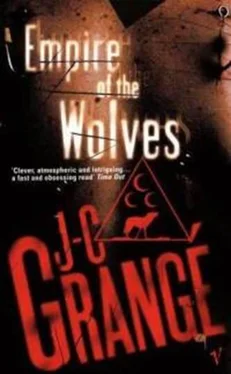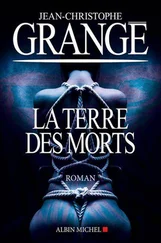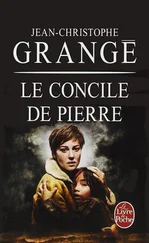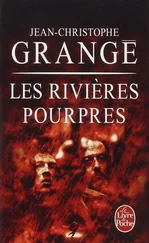Half an hour later, Paul crossed the Suresnes bridge and drove up Boulevard Sellier, then Boulevard de la République. He then went through the town of Saint-Cloud before reaching the outskirts of Garches.
The hospital finally appeared at the top of the hill. Fifteen acres of buildings, surgical theaters and white rooms. It was like a town, inhabited by doctors, nurses and thousands of patients, most of them victims of car accidents.
Paul drove toward the Vésale Unit. The sun was high and sparkled off the fronts of the brick buildings. Each wall offered a fresh tone of red, pink or cream, as though it had been carefully baked in an oven.
As they went on, they passed groups of visitors carrying flowers or cakes. Everyone walked with stiff, almost mechanical seriousness, as though contaminated by the surrounding rigor mortis.
They had now reached the inner courtyard of the unit. The gray-and pink building, with its porch supported by thin columns, looked like a sanatorium, or a spa concealing mysterious curative powers.
They walked into the morgue, following a corridor of white tiles. When they got to the waiting room, Schiffer asked: "Where are we now?"
It was not much, but Paul was pleased he could pull a little surprise on him.
A few years before, the Garches forensic unit had been renovated in rather an original way. The first room was painted entirely turquoise. The color covered the floor, walls and ceiling indifferently, thus wiping out any sense of scale or reference points. It was like plunging into a crystal sea, giving off a tonic limpidity. "The quacks in Garches called in a contemporary artist," Paul explained. "We're not in a hospital anymore, we're in a work of art."
A male nurse appeared and pointed to a door on their right. "Dr. Scarbon will join you in the departure hall."
They followed where he led, through further rooms that were also blue and empty, sometimes topped by a rim of white light, projected a few inches away from the ceiling. In the corridor, marble vases had been placed high on the walls, providing an array of pastel shades: pink, peach, yellow, ecru, white… Everywhere, there seemed to be a strange desire for purity at work.
The last room made Schiffer whistle in admiration.
It was a single rectangle of about a hundred square yards, absolutely empty and covered entirely in blue. To the left of the entrance, three high bay windows brought in light from outside. Facing these luminous forms, three arches had been cut into the opposite wall, like vaults in a Greek church. Within, a line of marble blocks, like huge ingots, which had also been painted blue, seemed to rise directly out of the floor.
On one of them, the shape of a body could be seen beneath a sheet. Schiffer went over to a white marble basin that stood in the middle of the room. Heavy and polished, it was full of water and resembled a plain holy-water basin of classical design. Moved by a pump, the sparkling water spun around, giving off a scent of eucalyptus, intended to lessen the stink of death and the smell of formaldehyde.
The officer dipped his fingers into it. "All this doesn't make me feel any younger."
At that instant, Dr. Scarbon could be heard approaching. Schiffer turned around. The two men looked each other up and down. Paul at once saw that they knew each other. When he had phoned the doctor from the retirement home, he had not mentioned his new partner.
"Thank you for coming, Doctor," Paul said, saluting him.
Scarbon nodded curtly, without taking his eyes off the Cipher. He was wearing a dark woolen coat and was still holding his kidskin gloves in his hand. He was old and emaciated. His eyes were constantly blinking, as if the glasses he wore on the tip of his nose were of no use to him. His bushy mustache filtered the Gallic tones in his drawling voice, as though he were a character in a pre- World War II movie.
Paul gestured toward his protégé. "Let me introduce you to-"
Schiffer butted in. "We know each other. Hi, Doctor."
Without answering, Scarbon took off his coat and put on one of the white coats that were hanging beneath a vault, then slipped on some latex gloves whose pale green color went well with the surrounding blue. Only then did he fold back the sheet. The smell of decaying flesh spread through the room, driving everything else out of their minds.
Despite himself, Paul looked away. When he had worked up the courage to look, he stared at the heavy white body, half hidden by the folded sheet.
Schiffer had stepped under the arch. He was now slipping on his surgical gloves. Not a trace of disgust could be seen on his face. Behind him, a wooden cross and two black iron chandeliers stood out against the wall. He murmured in hollow voice: "Okay, Doctor, you can begin."
"The victim is a Caucasian female. Her muscular tonicity indicates that she was between ages twenty and thirty. Rather plump. One hundred and fifty-four pounds and five foot three inches tall. If we add that she has the white pigmentation characteristic of redheads, and the hair to go with it, then it can be asserted that physically she matches the profiles of the first two victims. That's the way our boy likes them: thirtyish, plump, redheaded." Scarbon's voice was monotonous. It sounded as if he were mentally reading out the pages of his report, lines written during a sleepless night.
Schiffer asked, "No distinguishing sign?"
"Like what?"
"Tattoos. Pierced ears. Traces of a wedding ring. Things the killer couldn't get rid of."
"No."
The Cipher grabbed the corpse's left hand and turned it over, palm up. Paul shivered. Never would he have dared do such a thing.
"No traces of henna?"
"No."
"Nerteaux tells me that her fingers show that she was a seamstress. What's your opinion?"
Scarbon nodded. "These women had all clearly been doing manual work for some time."
"Do you agree that it was sewing?"
"It's hard to be really precise. There are marks of pinpricks in the lines of the fingers. There are also calluses between the thumb and the index. Maybe from using a sewing machine, or an iron." He looked up across the slabs. "They were found in the Sentier area, weren't they?"
"So?"
"They're Turkish workers."
Schiffer paid no attention to the certitude in Scarbon's tone. He was staring at the corpse. Paul managed to force himself to approach. He saw the dark lacerations covering the flanks, the breasts, shoulders and thighs. Several of them were so deep that they revealed the whiteness of the bones.
"Tell us about all this," the Cipher ordered.
The doctor quickly flicked through a set of stapled pages. "In this case, I counted twenty-seven wounds. Some are superficial; others are deep. It looks as if the killer intensified the torture as time went by. There were about the same number on the other two." He lowered his report to look at his questioners. "In general, everything I am now going to say applies to the previous victims, too. The three women were mutilated in the same way"
"With what sort of weapon?"
"A chrome-plated combat knife, with a jagged edge. The marks of the teeth can be seen on several of the wounds. For the first two bodies, I ordered some research to be done into the size and positioning of the teeth, but we didn't come up with anything of interest. It was standard military equipment, matching dozens of different models."
The Cipher bent down over the wounds that spread out over the chest-there were strange black halos there, suggesting love bites. When Paul had noticed this detail on the first body, it made him think of the devil-a creature of fire who had salivated over this innocent form.
"What about those?" Schiffer pointed. "What are they exactly? Bites?"
Читать дальше












